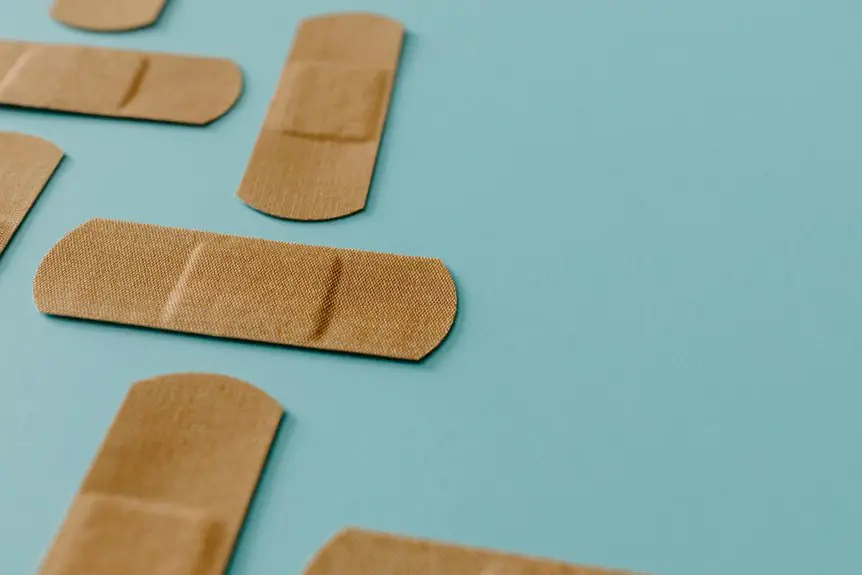Fabric bleeding happens when dyes transfer between fabrics, often due to poor-quality dyes, heat, and improper washing conditions. To stop this, wash new fabrics separately, use cold water with gentle detergent, and always follow care labels. Avoid mixing fabric types and consider conducting colorfastness tests. If bleeding occurs, rinse immediately and rewash with a color-safe detergent. There are effective solutions to manage and prevent these issues, which you might find interesting as you explore further.
Table of Contents
Key Takeaways
- Fabric bleeding often occurs due to poor-quality dyes, excessive heat, or incorrect washing conditions like temperature and detergent choice.
- To prevent bleeding, wash new fabrics separately using cold water and gentle detergents.
- Conduct colorfastness tests on hidden areas to check for potential dye transfer issues.
- Rinse affected fabrics immediately and soak in cold water to remove excess dye promptly.
- Use color-safe detergents and color catcher sheets when rewashing to prevent further dye bleeding.
Understanding Fabric Types and Their Dye Composition
When it comes to fabric, understanding the types and their dye compositions is essential for preventing issues like bleeding. Different fabrics, such as cotton, polyester, and silk, absorb dyes in unique ways.
Understanding fabric types and their dye compositions is crucial to preventing dye bleeding and maintaining vibrant colors.
For instance, natural fibers like cotton typically hold dyes well but can bleed if exposed to water or heat. On the other hand, synthetic fibers may resist fading but can also suffer from dye migration.
Knowing the dye type—reactive, direct, or acid—can help you choose the right washing method. Always check care labels and follow instructions to minimize risks.
Pre-washing or using color catchers can also make a difference. By being informed, you can better protect your fabrics from unwanted dye transfer and maintain their vibrant appearance.
The Role of Dye Adhesion in Fabric Bleeding
When it comes to fabric bleeding, dye adhesion plays a vital role in preventing issues.
If the dye doesn’t bond properly to the fabric, you’re likely to face unwanted color transfers.
Understanding the importance of proper dyeing can help you avoid these frustrating problems.
Importance of Proper Dyeing
Proper dyeing is essential for preventing fabric bleeding, as the effectiveness of dye adhesion directly impacts the longevity of color in textiles. When you choose fabrics, consider how well the dye bonds to the fibers. High-quality dyes that penetrate deeply enhance adhesion, making colors more resistant to fading and bleeding.
If you’re working with fabrics, guarantee that the dyeing process is done correctly, following recommended temperatures and settings. This helps secure the dye within the fabric structure. Additionally, pre-treating fabrics can improve dye absorption and reduce the risk of bleeding.
Effects of Poor Adhesion
If dye adhesion is inadequate, you’ll likely encounter significant fabric bleeding, which can ruin the appearance of your textiles.
When dyes don’t bond well to the fabric fibers, they can easily wash out or transfer to other materials. This not only affects the color vibrancy but can also lead to uneven patches that detract from your fabric’s overall look.
You might notice bleeding during laundering, especially in hot water or when mixed with other garments. To prevent this, always choose high-quality dyes and follow proper dyeing techniques.
Additionally, pre-treating fabrics and fixing the dyes can enhance adhesion, ensuring your textiles remain vibrant and intact, reducing the risk of unsightly bleeding in the process.
Washing Conditions That Contribute to Dye Leaching
Although many factors contribute to dye leaching, washing conditions play an essential role in exacerbating the problem.
When you wash your clothes in hot water, it can break down the dye’s bonds, causing it to bleed. Using harsh detergents can also strip away protective layers, making dyes more vulnerable.
If you overload your washing machine, garments rub against each other more, increasing friction and releasing dye. Additionally, washing dark and light colors together can lead to unwanted transfers.
Finally, frequent washing can weaken fibers and dyes, especially in delicate fabrics. By being mindful of these conditions, you can reduce the risk of dye leaching and keep your clothes looking fresh and vibrant longer.
Preventive Measures to Avoid Fabric Bleeding
To prevent fabric bleeding, start by choosing high-quality fabrics that are less likely to bleed in the first place.
You can also use pre-washing techniques to help set the dye before the fabric goes through regular washing.
Taking these steps will save you from potential color mishaps down the line.
Quality Fabric Selection
When selecting fabrics, you’ll want to prioritize quality to prevent issues like fabric bleeding. High-quality materials typically undergo more rigorous dyeing processes, ensuring colorfastness. Look for natural fibers like cotton, linen, or silk, as they often retain dyes better than synthetic options. Additionally, check for any certifications that indicate the fabric has been tested for color stability.
Here’s a quick comparison of fabric types:
| Fabric Type | Colorfastness | Recommended Use |
|---|---|---|
| Cotton | High | Clothing, Home Textiles |
| Polyester | Moderate | Activewear, Upholstery |
| Silk | Low | Formal Wear, Accents |
| Linen | High | Summer Garments |
| Rayon | Low | Blouses, Dresses |
Choosing wisely can save you from future laundry mishaps.
Pre-Washing Techniques
Choosing high-quality fabrics is just the first step in preventing fabric bleeding; pre-washing techniques play a crucial role too. Before wearing new items, always pre-wash them to remove excess dye. Use cold water and a gentle detergent to minimize color release.
Adding a cup of white vinegar during the rinse cycle can help set the colors, making them less likely to bleed later. You should also consider washing similar colors together to avoid any mishaps.
If you’re unsure about a fabric’s colorfastness, try a simple test: dampen a hidden area and blot it with a white cloth. If the dye transfers, you’ll know to take extra precautions.
These steps can greatly reduce the risk of fabric bleeding and keep your clothes looking vibrant.
Effective Solutions for Fixing Bleeding Issues
Although fabric bleeding can be frustrating, there are effective solutions to restore your garments.
First, act quickly by soaking the affected area in cold water, which can help lift the excess dye.
Next, try using a color remover or a gentle stain remover specifically designed for fabrics. Always test these products on a hidden area to verify they won’t cause further damage.
If the bleeding persists, consider rewashing the entire garment with a color-safe detergent and adding a color catcher sheet to absorb any loose dye.
Finally, air-dry your clothing instead of using a dryer, as heat can set any remaining stains.
With these steps, you can often rescue your favorite pieces from fabric bleeding.
The Impact of Dye Migration on Fabric
Dye migration can wreak havoc on your fabrics, altering their appearance and potentially ruining your favorite garments. When dyes from one fabric bleed into another, it creates unsightly stains that are often difficult to remove.
You might notice colors running together, especially during washing or exposure to moisture. This can make your once-vibrant clothes look dull and mismatched.
Additionally, dye migration can affect different fabric types in varying ways, causing some materials to absorb colors more readily than others. If you’ve invested in quality clothing, the last thing you want is for dye issues to compromise their look.
Understanding how dye migration occurs can help you take proactive steps to prevent it and keep your wardrobe looking its best.
Long-Term Strategies for Maintaining Fabric Integrity
To protect your fabrics from dye migration and maintain their integrity, adopting long-term strategies is key.
First, always wash your fabrics in cold water with a gentle detergent to minimize color fading. Avoid using bleach, as it can weaken fibers and promote bleeding.
Store your fabrics in a cool, dry place away from direct sunlight, which can cause colors to fade over time. Consider using color catchers during laundry to absorb any loose dyes.
Regularly inspect your fabrics for signs of wear or damage, and address them promptly to prevent further issues.
Finally, when possible, choose high-quality fabrics that are less prone to bleeding, ensuring your textiles remain vibrant and intact for years to come.
Frequently Asked Questions
Can Fabric Bleeding Occur With New Clothing Items?
Yes, fabric bleeding can occur with new clothing items, especially if they haven’t been pre-washed. It’s smart to wash them separately or with cold water to minimize the risk of colors running onto other fabrics.
How Can I Test for Dye Stability Before Washing?
Ah, the art of dye stability testing—truly a riveting endeavor! Simply dampen a white cloth, rub it on the fabric, and behold! If color transfers, you’ve got a potential bleeding situation waiting to happen.
Are There Specific Brands Known for Dye Bleeding Issues?
Yes, some brands are infamous for dye bleeding issues. You might notice that cheaper or lower-quality fabrics tend to bleed more. It’s wise to research reviews and choose reputable brands to avoid potential problems.
What Should I Do if My Quilt Starts Bleeding?
If your quilt starts bleeding like a burst water balloon, act quickly. Rinse it in cold water, add a color catcher, and wash separately. Avoid heat until you’re sure the bleeding’s stopped.
Is Fabric Bleeding Reversible for All Types of Fabrics?
Fabric bleeding isn’t always reversible. It depends on the fabric type and dye. You should act quickly, using specific treatments to minimize damage. Always test on a small area first to gauge effectiveness before proceeding.
- What Is Scrim Fabric Used For? 10 Surprising Applications - June 26, 2025
- How Is Scrim Fabric Made? From Fiber to Open-Weave Mesh - June 26, 2025
- Cotton Scrim Fabric: Exploring Its Uses in Theatre, Art, and Crafts - June 26, 2025







